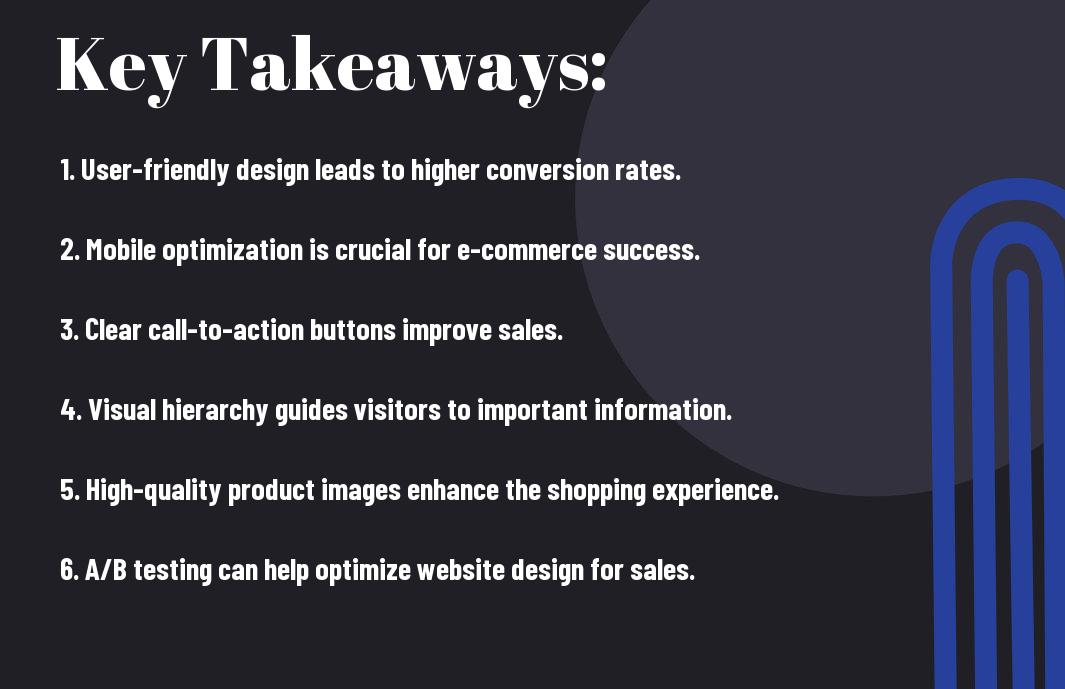Are you looking to optimize your e-commerce website to maximize sales and revenue? Your website’s design plays a crucial role in attracting and retaining customers, ultimately impacting your bottom line. In this blog post, we will discuss how you can leverage website design to increase your e-commerce sales and revenue. From creating a user-friendly interface to optimizing for mobile devices, we will cover the most important and dangerous details to positively impact your online business. Stay tuned for expert tips and strategies to take your e-commerce site to the next level.
Key Takeaways:
- User Experience is Key: Prioritize user-friendly design and navigation to improve the customer’s online shopping experience.
- Optimize for Mobile: Ensure your website is responsive and functions seamlessly on all devices, as a large portion of e-commerce traffic comes from mobile users.
- Utilize High-Quality Imagery: Invest in professional product photography to showcase your items in the best light and entice customers to make a purchase.
- Streamline Checkout Process: Simplify the buying process by minimizing steps and offering guest checkout options to reduce cart abandonment rates.
- Implement Social Proof Elements: Incorporate customer reviews, testimonials, and trust badges to build trust and credibility, ultimately boosting sales.

Optimizing Website Aesthetics for User Engagement
Now, let’s talk about how you can optimize your website aesthetics to engage users and increase e-commerce sales. According to a case study by Acquire, a well-designed website can increase sales by up to 200%. It’s important to understand the elements that contribute to a visually appealing website that captures the attention of your target audience.
Understanding Color Psychology and Brand Consistency
Color psychology plays a crucial role in influencing consumer behavior and perceptions. The colors you choose for your website can evoke specific emotions and create a memorable brand experience. It’s essential to align your color scheme with your brand identity to create a cohesive and consistent visual representation across all digital touchpoints. Consistency in your branding helps to build trust and recognition, ultimately leading to higher conversion rates and increased revenue.
The Role of High-Quality Images and Multimedia Content
High-quality images and multimedia content are essential for showcasing your products and creating an immersive shopping experience for your customers. The use of engaging visuals can captivate your audience and convey the value of your products more effectively than text alone. Investing in professional photography and compelling multimedia content can significantly enhance the overall look and feel of your website, ultimately leading to higher user engagement and increased sales.
Enhancing User Experience for Increased Conversion Rates
Despite having an attractive website design, enhancing user experience is crucial for increasing conversion rates. When users have a seamless and enjoyable experience on your e-commerce website, it increases the likelihood of them making a purchase. There are several key elements to focus on in order to maximize the user experience and drive higher conversion rates.
Mobile Responsiveness and Cross-Platform Compatibility
Mobile responsiveness and cross-platform compatibility are essential for catering to the growing number of mobile shoppers. Your e-commerce website should be optimized to provide a seamless experience across all devices, including smartphones, tablets, and desktop computers. By ensuring that your website is easily accessible and fully functional on all platforms, you can capture a wider audience and increase the likelihood of conversion. Responsive design will adapt to different screen sizes, ensuring that users can navigate and make purchases comfortably on any device.
Streamlining Navigation and Simplifying Checkout Processes
Complicated navigation and checkout processes can lead to abandoned carts and lost sales. Streamlining navigation by organizing products into clear categories and providing intuitive search functionality makes it easier for users to find what they’re looking for. Additionally, simplifying the checkout process by minimizing the number of steps and offering guest checkout options can significantly reduce friction and increase the likelihood of completing a purchase. By removing obstacles and providing a smooth user experience, you can effectively boost conversion rates and drive revenue.
To
Leverage SEO and Content Marketing
To drive more traffic to your e-commerce website and increase your sales revenue, it’s essential to leverage the power of SEO and content marketing. These strategies are crucial for increasing your online visibility and attracting potential customers. To learn more about leveraging the power of e-commerce marketing for your business’s success, check out this insightful article on Leveraging the Power of E-commerce Marketing for ….
Integrating SEO Best Practices into Website Design
When it comes to website design, integrating SEO best practices is crucial for improving your site’s search engine rankings. This includes utilizing appropriate keywords, optimizing meta titles and descriptions, and ensuring that your website is mobile-friendly. By incorporating these strategies into your website design, you can attract more organic traffic and improve your overall online visibility.
Creating Valuable Content to Drive Traffic and Sales
Creating high-quality, valuable content is essential for driving traffic and increasing sales on your e-commerce website. This can include blog posts, product descriptions, videos, and infographics that provide useful information to your target audience. Not only does valuable content attract visitors to your site, but it also helps establish your brand as an authority in your industry, ultimately leading to increased sales and revenue.

Utilizing Data Analytics and Feedback for Continuous Improvement
For a comprehensive approach to increasing e-commerce sales and revenue, it is crucial to utilize data analytics and feedback. By analyzing the data from your website and customer feedback, you can gain valuable insights into your customers’ behavior, preferences, and pain points. This information can help you make informed decisions about your website design and marketing strategies. Check out this comprehensive guide on Strategies for Boosting E-Commerce ROI for more insights on leveraging data analytics for e-commerce success.
Implementing Tools for Tracking User Behavior
Tracking user behavior is essential for understanding how your customers interact with your website. By using tools such as Google Analytics, heatmaps, and click tracking, you can gain valuable insights into which areas of your website are performing well and where there may be room for improvement. This data can help you optimize your website design and user experience to increase conversions and sales.
Adapting Design Based on Customer Feedback and Performance Metrics
Customer feedback and performance metrics provide valuable insights into how your website design is resonating with your target audience. By collecting feedback through surveys, reviews, and customer support interactions, you can identify areas for improvement and adapt your website design to better meet your customers’ needs. Additionally, monitoring key performance metrics such as bounce rate, time on page, and conversion rate can help you identify areas of your website that may need attention. By leveraging this data, you can continually adapt and optimize your website design to drive e-commerce sales and revenue.
The Importance of Leveraging Website Design for E-Commerce Success
The key to increasing e-commerce sales and revenue lies in leveraging your website design. By creating a user-friendly, visually appealing, and seamless online shopping experience, you can capture the attention of potential customers and keep them engaged throughout the purchasing process. Utilizing strategic placement of call-to-action buttons, optimizing for mobile accessibility, and enhancing overall site performance can make all the difference in converting visits into sales. Remember, your website is your digital storefront, and investing in its design can lead to significant returns in the form of increased conversions and revenue. By prioritizing website design in your e-commerce strategy, you can position yourself for long-term success in the online marketplace.
FAQ
Q: How can website design be leveraged to increase e-commerce sales and revenue?
A: Website design can be leveraged by optimizing the user interface, improving loading speed, and enhancing the overall user experience to make it easier for customers to navigate, find products, and complete purchases.
Q: What are some key design elements that can impact e-commerce sales?
A: Key design elements that can impact e-commerce sales include clear and compelling product images, easy-to-use navigation menus, streamlined checkout processes, and mobile responsiveness for a seamless shopping experience across devices.
Q: How does website design affect customer trust and confidence in an e-commerce business?
A: A well-designed website with a professional and polished look instills confidence in customers by signaling credibility and trustworthiness. It also helps in establishing a strong brand identity, which can further contribute to customer trust.
Q: What role does website loading speed play in increasing e-commerce sales and revenue?
A: Slow website loading speed can lead to high bounce rates and abandoned shopping carts, negatively impacting sales and revenue. Optimizing website loading speed through design improvements and technical enhancements is crucial for keeping potential customers engaged and converting them into buyers.
Q: How can businesses measure the effectiveness of their website design in driving e-commerce sales and revenue?
A: Businesses can measure the effectiveness of their website design by analyzing key performance metrics such as conversion rates, average order value, bounce rates, and time-on-page. Additionally, gathering customer feedback and conducting usability testing can provide valuable insights into how the website design is impacting sales and revenue.
